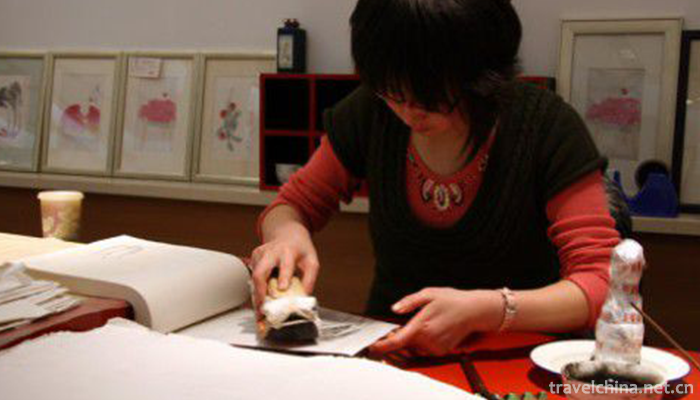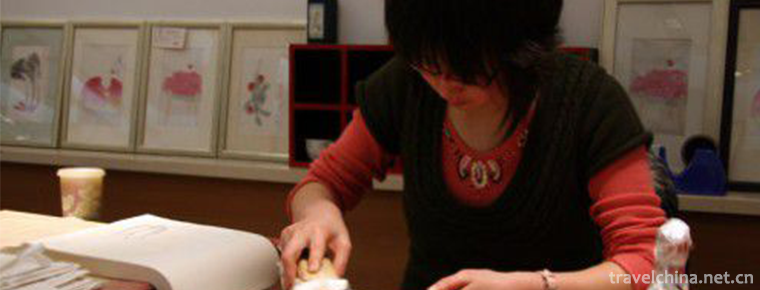Wood Watermarking Techniques
Wood Watermarking Techniques
Wooden watermarking, the traditional handicraft of Rongbaozhai, Beijing, is one of the national intangible cultural heritages.
Wooden watermarking is mainly made by such basic technological procedures as hook (sub-plate), engraving (plate-making), printing (printing) and special techniques as engraving, picking and dusting.
On May 20, 2006, woodblock watermarking technology was approved by the State Council to be included in the first batch of national intangible cultural heritage list, project number_-77.
historical origin
Wood watermarking technology has a long history in China. As early as 868 A.D. (the Ninth Year of Xiantong in the Tang Dynasty), a man named Wang Jie used this technique to carve illustrations of the title page of the Diamond Sutra, which was handed down to the world. Since the Tang Dynasty, books have been mostly illustrated, and color overprinting began in the sixteenth century. Later, on the basis of this traditional skill, Rong Baozhai continuously improved and innovated. In 1896, Rong Baozhai set up a set of postings, hired masters of engraving and printing, and printed a large number of exquisite poems and letterheads. During the period of the Republic of China, Rong Baozhai republished "Shi Zhu Zhai Zhu Ji Pu", which made the color overprint and arch flower technique continue and develop.
After the founding of the People's Republic of China, Rong Baozhai's woodcut watermarking developed from the original poems and letters that could only print less than a foot in size to the large works of art such as "Running Horse Tu" with vivid pen and ink, bold and bold momentum, and "Hang Hua Waitress Tu" by Zhou Fang of the Tang Dynasty and "Ta Ge Tu" by Ma Yuan of the Song Dynasty, which marked the peak of the development of engraving printing. Rongbaozhai wood watermarking technology has really matured.
Technological characteristics
The woodcut watermarking is based on the length of the handwriting, curved square circle, rigid, soft and dry, the shade, shade, cold and warm, and the color of the back Yin and Yang partitioned copy, carved into a number of plates, and then compared with the original, from deep to shallow, one by one, overlap, in order to make the original, accurate and accurate, to achieve the degree of chaos and authenticity.
Technological process
Wood block watermarking is a pure handmade printing process with such basic processes as hook (sub-plate), engraving (plate-making), printing (printing) and special techniques as engraving, picking, dusting and drawing. It is based on pen, knife, brush, rake, Chinese painting pigments, water and other materials, and aims at restoring the artistic form, brush, ink and grace of traditional calligraphy and painting.
(1) Sketch: The painter is responsible for this work. The first step is to separate the colors, that is, to divide all the handwriting of the same tone on the draft into a set of plates, and to divide the picture into several sets of plates. There are two or three to eight or nine sets of simple colour pictures, and dozens of sets of elaborate and complicated pictures, and even hundreds to 1600 sets of large-scale pictures (e.g. Hanhua Ladies Picture Volume). When sketching, first cover the original work with celluloid plate (i.e. transparent film plate) and follow the sketch; then cover the sketched Celluloid plate with very thin swallow paper. The future drawings will be delineated, and their strokes and charm will be checked repeatedly with great fineness to see if they are different from the original works. Later, several sets of alternate editions are outlined from the original tone and printing requirements.
(2) Stereotype: This is the second important process of woodblock watermarking, that is, to glue the drawings hooked on swallow paper onto the board and carve. In addition to carving on the basis of ink lines, the author also needs to refer to the original work, carefully understand it and use a knife as a pen, in order to convey the spirit and style of the original vividly.
(3) Printing: This is the last process of woodcut watermarking. After each block is engraved, each block is successively printed into a set of pictures. Paper (or silk), ink, color and other materials used in printing are identical to the original materials.
Inheritance and Protection
Inheritance value
Wood block watermarking is a kind of reproduction technology, which is a traditional folk art in China. It integrates painting, sculpture and printing. According to the penetration principle of ink and wash, it shows the rhyme of brush strokes and ink. It can be used to create artistic works reflecting its own characteristics, and also to reproduce all kinds of Chinese calligraphy and paintings vividly. It is the crystallization of the great wisdom of the Chinese nation.
Current situation of inheritance
Rongbaozhai woodblock watermarking inherits and develops the traditional Chinese woodblock printing technology. Its technological process has ornamental value and should be protected and inherited. Now the wood-based watermarking is experiencing the test of lack of successors and high market operating costs. It needs the help of relevant parties to help solve the difficulties and get out of the trough.
Heritage figures
Chong Defu, male, Manchu, born in Beijing in 1954. In June 2007, Chong Defu was selected as the representative successor of the first batch of national intangible cultural heritage projects and declared by Rongbaozhai, Beijing.
Wang Liju, a Han nationality, was born in Beijing in 1959. In June 2007, Wang Liju was selected as the representative successor of the first batch of national intangible cultural heritage projects and declared by Rongbaozhai, Beijing.
Jiang Min, male, Han nationality, born in 1941, now lives in Shanghai. In June 2009, Jiang Min was selected as the representative successor of the third batch of national intangible cultural heritage projects, which was declared by Shanghai Painting and Calligraphy Publishing House.
Xiao Gang, male, Han nationality, born in May 1959 in Beijing. In December 2012, Xiao Gang was selected as the representative successor of the fourth batch of national intangible cultural heritage projects, declared by Rongbaozhai, Beijing.
protective measures
In 1950, Zhang Yangling, the head of the printmaking department of the East China Branch of the Central Academy of Fine Arts (now the predecessor of the Chinese Academy of Fine Arts), established the earliest woodblock watermarking studio in China.
In 1957, Zhejiang Academy of Fine Arts set up a watermarking factory, during which Xu Yinsen and Zhang Gengyuan were sent to study and communicate with Rongbaozhai and Douyun Xuan, which made Hangzhou woodblock watermarking technology a qualitative leap and became one of the four major woodblock watermarking bases in the country at that time (Rongbaozhai, Douyun Xuan, Yang Liuqing, Zhemei Watermarking Factory).
social influence
Important Exhibitions
On May 8, 2015, more than 300 pieces of Rongbao Zhai's woodblock watermarking works were exhibited at the Hohhot Museum of Nationalities. Several artists, such as Gao Wenying, Xiao Gang and Zhao Huiping, who are the national non-genetic successors of woodblock watermarking, personally demonstrated and explained the production method and process of woodboard watermarking to the visitors.
Honorary recognition
The woodblock watermarking work "Mrs. Guo Guo's Spring Picture" was nominated for the first National Book Award in 1994.
The woodblock watermarking work Shizhu Zhai Zhupu won the third prize of the 2nd National Excellent Art Book Award.


-
1.Mount Tai
Mount Tai, also known as Daishan, Daizhong, Daiyue, Dongyue, Taiyue, is located in the central part of Shandong Province, belonging to Tai'an City, stretching between Tai'an, Jinan, Zibo, with a total
Time 2018-10-28 -
2.Gutian tourist area
It is understood that in 2008, Gutian Tourist Area was rated as a national 4A-level tourist attraction. In 2013, in order to further promote the development of tourism industry and upgrade the brand
Time 2018-12-08 -
3.Yuelu Mountain and Orange Prefecture Tourist Area
Orange Island Scenic Area is located in the heart of the Xiangjiang River opposite Changsha City, Hunan Province. It is the largest famous island in the Xiangjiang River with an area of 91.4 hectares
Time 2018-12-12 -
4.Lingnan Impression
Lingnan Impression Park is located in the south of Guangzhou University Town (Xiaoguwei Island). It covers an area of 16.5 hectares. It is a tourist attraction that gathers sightseeing
Time 2019-02-03 -
5.Pile brocade
Duijin, also known as Shangdang Duijin, is a handicraft hand Duijin is developed on the basis of traditional Chinese painting and embroidery. It is made of silk as the main fabric
Time 2019-04-28 -
6.Boxwood carving
Boxwood carving is one of the traditional folk carving arts in Zhejiang Province. It uses boxwood as carving material and uses the natural form of boxwood, which is smooth, delicate in texture and sol
Time 2019-05-04 -
7.Cao Yu pen name of Wan Jiabao
Cao Yu (September 24, 1910 - December 13, 1996) writer better known as Cao Yu Xiaoshi, Xiaoshun Jia, Han nationality, native to Hubei. Qianjiang Born in a declining feudal bureaucratic family in Tianj
Time 2019-09-07 -
8.China Foreign Affairs University
China Foreign Affairs University is a small scale, high level and distinctive foreign ministry's sole institution directly under the guidance of serving the cause of China's diplomacy and cultivating
Time 2019-11-29 -
9.Notes on Tourism in Ganzi Prefecture
1. Ganzi Prefecture is characterized by Tibetan culture, snow mountain and grassland scenery, with high average sea level. Most people will have altitude reaction when they go to Ganzi Prefecture. To prevent and deal with altitude reaction, please refer to the precautions for altitude reaction.
Time 2020-12-06 -
10.History of Luzhou
Luzhou was named "Lushui theory" and was called Jiangyang in ancient times. During the reign of Liang Datong in the Southern Dynasty (535-546 A.D.), Luzhou was set up to lead the Yangjun county. Jiangyang County: Jiangyang county (governing today's Jiangyang District),
Time 2020-12-14 -
11.Soil characteristics of Suining
The strata in Suining City are mainly limestone in the lower part and purplish red sandy soil and mudstone in the upper part. Therefore, Suining area is also known as "red soil land".
Time 2020-12-16 -
12.Sports in Yibin
In 2019, Yibin sports team (member) won 4 world-class gold medals, 15 national gold medals, 30 provincial gold medals, 38 silver medals and 41 bronze medals. The annual sales of sports lottery tickets reached 410 million yuan, and 15 million yuan of public w
Time 2020-12-18